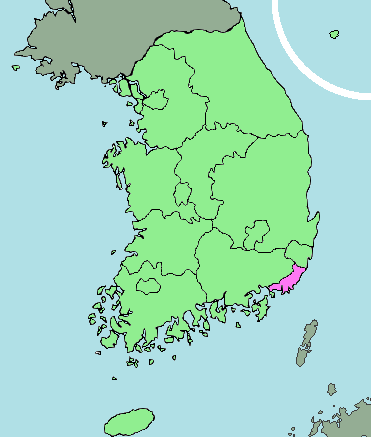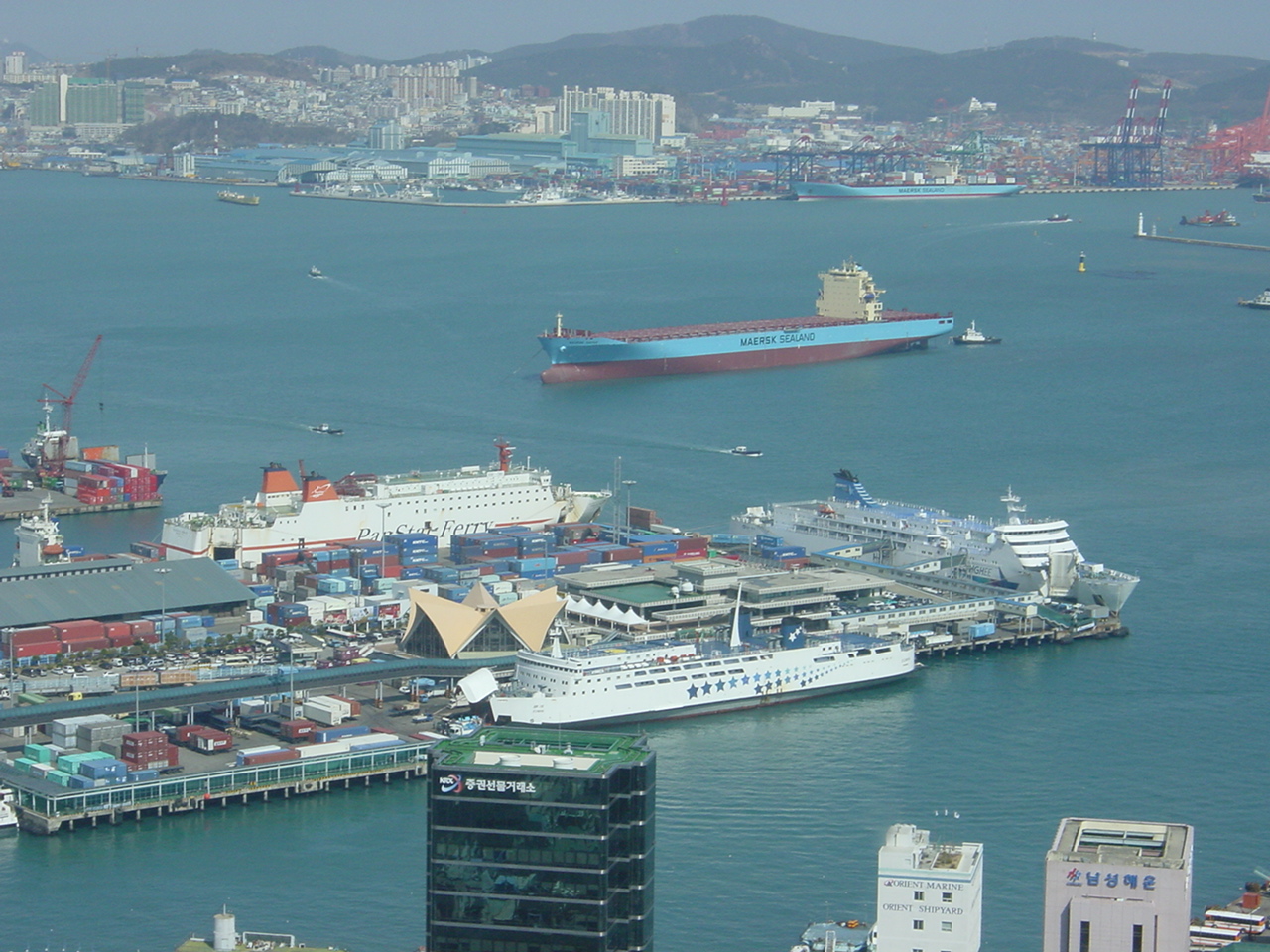<Back to Index>
- Republic of Korea Busan Metropolitan City, 14.2M TEUs
PAGE SPONSOR


Busan (Officially Busan Metropolitan City), formerly spelled Pusan, is South Korea's second largest metropolis after Seoul, with a population of around 3.6 million. The Metropolitan area (includes adjacent cities of Gimhae and Yangsan) population is 4,399,515 as of 2010. It is the largest port city in South Korea and the world's fifth busiest seaports by cargo tonnage. The city is located on the southeasternmost tip of the Korean peninsula. The most densely built up areas of the city are situated in a number of narrow valleys between the Nakdong River and Suyeong River, with mountains separating some of the districts. Administratively, it is designated as a Metropolitan City. The Busan metropolitan area is divided into 15 major administrative districts and a single county.
Busan was the host city of the 2002 Asian Games and APEC 2005 Korea. It was also one of the host cities for the 2002 FIFA World Cup, and is a center for international conventions in Korea. On November 14, 2005, the city officially announced its bid to host the 2020 Summer Olympics Games. After Pyeongchang's successful bid for the 2018 Winter Olympics, the city is considering its bid to host the 2024 or 2028 Summer Olympics.
Busan is home to the world's largest department store, the Shinsegae Centum City and is pursuing a large number of multi - skyscraper projects, including Solomon Tower (108 floor, 418m), Haeundae Resort Tower (108 floor, 478m), the 110 floor, 510m supertall Lotte Super Tower, which is slated to become the world's fifth tallest building in 2015, after Burj Khalifa, Shanghai Tower, Abraj Al Bait Towers, and One World Trade Center.
Geochilsan-guk existed in the second and third and fourth centuries as a chiefdom of Jinhan. It was absorbed by Silla and renamed Geochilsan-gun. The word Geochilsan means rough mountain, probably referring to Hwangnyeongsan, located at the center of the city.
The grave goods excavated from mounded burials at Bokcheon-dong indicate that a complex chiefdom ruled by powerful individuals was present in the Busan area just as the Three Kingdoms of Korea were forming, c. A.D. 300 – 400. The mounded burials of Bokcheon-dong were built along the top of a ridge that overlooks a wide area that makes up parts of modern day Dongnae-gu and Yeonje-gu. Archaeologists excavated more than 250 iron weapons and ingots from Burial No. 38, a wooden chamber tomb at Bokcheon-dong.
In 757, Geochilsan-gun was again renamed Dongnae, which it is still called.
From the beginning of the fifteenth century, the Korean government designated Busan as a trading port with the Japanese and allowed their settlement. Other Japanese settlements in Ulsan and Jinhae diminished later, but the Busan settlement, called Waegwan at the time, continued until Japan invaded Korea in 1592. After the war, diplomatic relations with the new shogunate in Japan were established in 1607, and Busan Waegwan was permitted to be reconstructed. The Japanese settlement, though relocated into Choryang later, continued to exist until Korea was exposed to modern diplomacy in 1876. In 1876, Busan became the first international port in Korea.
During the Japanese rule, Busan (known in Japanese also as Busan) developed into a hub trading port with Japan. Busan was the only city in Korea to adopt the steam tramway before electrification was introduced in 1924.
During the Korean War, Busan was one of only two cities in South Korea not captured by the North Korean army within the first three months of the War, as a result the city became a refugee camp site for Koreans during the war, along with Daegu.
As Busan was one of the few areas in Korea that remained under the control of South Korea throughout the Korean War, for some time it served as a temporary capital of the Republic of Korea. UN troops established a defensive perimeter around the city known as the Pusan Perimeter in the summer and autumn of 1950. Since then, like Seoul, the city has been a self governing metropolis and has built a strong urban character.
In 1963, Busan separated from Gyeongsangnam-do to become a Directly Governed City (Jikhalsi). In 1983, the provincial capitol of Gyeongsangnam-do was moved from Busan to Changwon.
In 1995, Busan became a Metropolitan City (Gwangyeoksi).
Busan's names include Pusan-gwangyŏksi (approved), Pusan, Fusan, Fuzan-fu, Husan, Husan Hu, Pusan-chikhalsi, Pusan-jikhalsi, Pusan-pu and Pusan-si.
The city was originally called Busanpo. It was named after the shape of the mountain behind Busan Port. Korean bu (hangul: 부, hanja: 釜) means a cauldron, san (hangul: 산, hanja: 山) means a mountain, and po (hangul: 포, hanja: 浦) means a harbor. It may be said that a harbor is located at the foot of a mountain resembling a cauldron. Since the late 15th century, the current name Busan (hangul: 부산, hanja: 釜山) has been widely used.
Busan is located on the Southeastern tip of the Korean Peninsula.
It is located on the coast, which determined the development of the
whole city itself. It is the nearest of South Korea's six largest cities
to Japan. The distance as the crow flies from Busan to Tsushima Island, Japan, is about 49.5 km (31 mi), to Fukuoka, Japan, about 180 km (112 mi), and by contrast, to Seoul about 314 km (195 mi). Busan borders low mountains on the north and west, and the seas on the south and east. The Nakdong River Delta is located on the west side of the city, and Geumjeongsan, the highest mountain in the city, on the north. The Nakdong River, South Korea's longest river, flows through the west and empties into the Korea Strait.
Located on the Southeasternmost tip of the Korean Peninsula, Busan has a humid subtropical climate (Köppen climate classification Cfa). Extremely high or low temperatures are rare. May to July, late Springs and early Summers, are usually cooler than inland region because of the ocean effect. late Summer and early Autumn, August and September, are generally hot and humid and the city may experience typhoons at that time and be generally rainy. On September 15, 1959, Super Typhoon Sarah passed by the coast of the city and caused catastrophic damage. An unusually severe storm on September 12, 2003, Typhoon Maemi, also caused damage to ships and buildings and resulted in over 48 fatalities.
October and November are generally the most comfortable, with clear skies and pleasant temperatures. Winters are cold and comparatively dry with high winds, but much milder than other parts of Korea except Jeju-do and several islands of the southern coast. Busan and the nearby area has the least amount of snow compared to other regions of Korea due to its location. Snow falls on an average of only about 6 days per year. Even a little accumulation of snow can effectively shut down this seaport city because of the hilly terrain and unfamiliarity of motorists with driving on snow.Busan is the fifth busiest seaport in the world, with transportation and shipping among the most high profile aspects of the local economy. Since 1978, Busan has opened three container ports including Jaseungdae, Shinsundae, and Gamman. Busan has one of the world's largest ports and can handle up to 13.2 million TEU shipping containers per year.
The Busan - Jinhae Free Economic Zone Authority, one of two such administrations (the other in the harbor of Incheon), was created to reassert Busan's status as a traditional international trading center. The port attracts ships from all over the globe and the surrounding area aspires to become a regional financial center.
Korea Exchange (KRX), Korea's sole securities exchange operator, is headquartered in Busan.
Busan is the home of the headquarters of Renault - Samsung Motor, Hanjin Heavy Industries, Busan Bank, Air Busan, Hi Investment & Securities, Woori Aviva Life Insurance, Korea Technology Finance Corporation, Korea Asset Management Corporation.
Jagalchi Fish Market is the oldest and the largest fish market in Korea.
Busan is ranked the fourth best city after Singapore, Seoul, Tokyo
among the Asia's top convention cities in a 2011 global ranking by the International Congress and Convention Association (ICCA).
Commercial areas are dispersed through the city near busy intersections and adjacent to university campuses, but the two largest central business districts in Busan are Seomyeon and Gwangbok-dong / Nampo-dong. There are also four substantial shopping areas of note: Seomyeon, Gwangbok-dong, Busan Dae Hakap in Jangjeon-dong, and Centum City in Haeundae-gu.
Seomyeon is the crossroads of Busan. The local subway station serves two lines and is one of the busiest in the city. The local head offices of Korean and international banks are located in Seomyeon. It is recognized as the ascendant shopping and entertainment district. It is also home to "Seomyeon Medical Street", the district encompassing the 1 km radius range around Lotte Department Store in Seomyeon and the Buam subway station. The Street is home to a total of 160 cosmetic and other medical clinics, including those specializing in cosmetic surgery, dermatology, ophthalmology and dentistry. Directly adjacent to Seomyeon is Bujeon Market, the largest traditional market in the city. Other companies with offices here include Yeolmae Food.
The Gwangbok-dong, Nampo-dong, and Jungang-dong areas form the old central business district. Some of the restaurants in this district use family recipes passed down the generations. Jagalchi Market is an area of narrow street stalls and is well known for its fish market. The Gukje Market is also located nearby. Jungang-dong is the home of many international law offices, the old Immigration Office, and the international ferry terminal serving Japanese routes. Lotte World II is currently under construction along the water between Jungang-dong 7-Ga and 8-Ga.
Centum City, an industrial complex, is a popular new shopping area with luxury department stores.